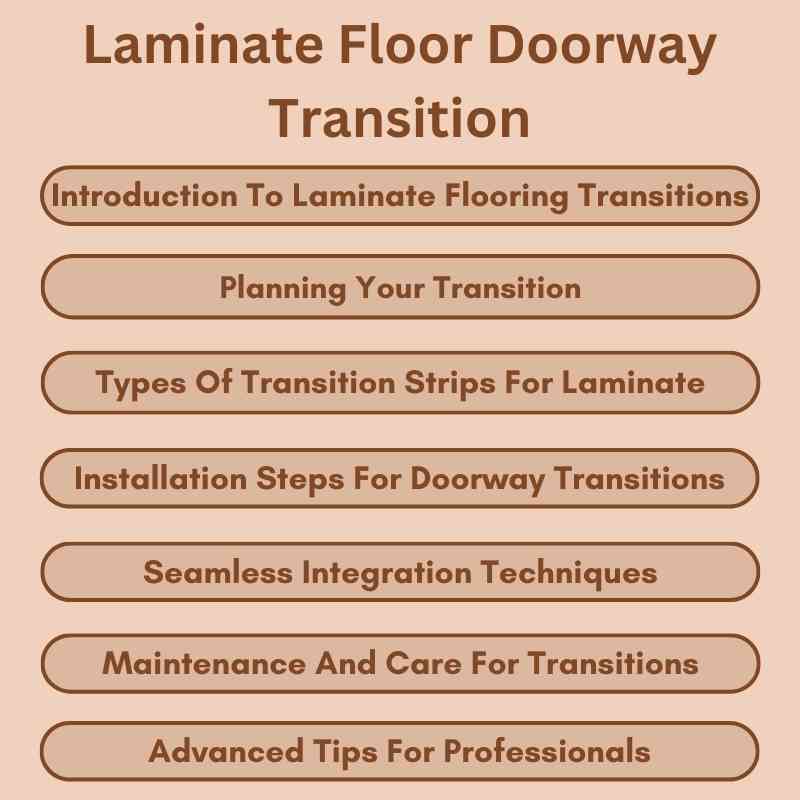A laminate floor doorway transition serves to bridge two different flooring types seamlessly. It protects edges and provides a finished look.
Doorway transitions are essential for maintaining a polished appearance between rooms with varying flooring materials. These transitions help prevent tripping hazards and protect the edges of laminate flooring from damage. Various types are available, including T-moldings, reducers, and end caps, each serving a specific purpose.
Choosing the right transition ensures a smooth flow from one area to another while enhancing the overall aesthetic of your space. Proper installation is crucial for durability and functionality. Understanding the different styles and their applications will help you make informed decisions for your home or office. Emphasizing quality and design will elevate your interior decor effortlessly.
Introduction To Laminate Flooring Transitions
Laminate flooring transitions are very important for a smooth look. They help connect different flooring types seamlessly. A good transition prevents tripping hazards and protects edges from damage.
Choosing the right transition type is key. Options include T-molding, which is great for connecting two laminate floors. Reducer strips are perfect for joining laminate to a lower floor. End caps work well for laminate against carpet.
Using the right transition makes any space look professional. It also keeps your floors in great shape for years to come.

Planning Your Transition
Measuring doorways is very important for a smooth laminate floor transition. Use a tape measure to find the width of the doorway. Measure from one side of the frame to the other. Note this measurement for later use.
Choose transition strips that match your laminate flooring. Options include T-molding, end caps, and reducers. Each serves a different purpose. T-molding works well for connecting two floors of the same height. End caps are ideal for doorways with carpet. Reducers help when the floors are at different heights.
Consider the material of the transition strips. Wood, vinyl, and aluminum are common choices. Select a material that complements your room’s style. Make sure it is durable and easy to install.
Types Of Transition Strips For Laminate
T-Molding is perfect for connecting two laminate surfaces. It works well on even floors. This strip allows for natural expansion and contraction of the flooring.
Reducer strips are ideal for uneven flooring. They bridge the gap between two different heights. This ensures a smooth transition and prevents tripping hazards.
End caps finish the edges of a room. They cover the space between laminate and other types of flooring. This strip provides a clean look and protects the edges.
Installation Steps For Doorway Transitions
Start by ensuring the subfloor is clean and dry. Remove any debris or old flooring. Check for levelness using a straight edge. Fill any low spots with a suitable compound.
Next, measure the doorway width. Cut the transition strip to fit perfectly. Use a miter saw for clean edges. Ensure the cut is smooth and straight.
To secure the transition strip, place it in the doorway. Use adhesive or nails based on the type of strip. Make sure it is firmly attached and aligned correctly. Allow the adhesive to dry as per the manufacturer’s instructions.
Seamless Integration Techniques
Choose laminate floor colors that match your room’s decor. This will create a harmonious look. Consider the shade of your walls and furniture. Neutral tones often work well with many styles.
Use color samples to visualize how the floor will look. Place samples next to your existing decor. This helps in making the right choice.
For flush alignment, ensure the subfloor is level. An uneven surface can cause gaps. Use a transition strip to cover slight height differences. This will provide a neat finish.
Troubleshooting Common Issues
Gaps in your laminate floor can be annoying. Fill these gaps with flooring filler. This will make your floor look neat. Use a putty knife for best results.
Height differences can cause tripping hazards. Use a transition strip to cover these changes. Choose a strip that matches your floor’s color.
Loose strips can create problems. Check them regularly to ensure they are secure. Use construction adhesive to fix any loose areas. Press down firmly for a good bond.
Maintenance And Care For Transitions
To keep laminate floor transitions in great shape, regular cleaning is key. Use a soft broom or a vacuum to remove dust. A damp mop with a gentle cleaner works well for deeper cleaning. Avoid harsh chemicals that can harm the laminate.
Preventing wear and tear is essential. Place mats at doorways to catch dirt and moisture. Avoid dragging furniture across transitions. Consider using felt pads on furniture legs to minimize scratches.
| Tip | Action |
|---|---|
| Regular Cleaning | Use a soft broom or damp mop. |
| Use Mats | Place mats at doorways. |
| Avoid Dragging | Lift furniture when moving. |
| Felt Pads | Attach to furniture legs. |
Advanced Tips For Professionals
Custom fabrication of transition strips can enhance any laminate flooring project. Proper measurements ensure a perfect fit. Materials like wood, metal, or vinyl can be used. Choose materials that match the laminate for a seamless look. This attention to detail creates a polished finish.
Aesthetic considerations are crucial for high-end finishes. Color and texture should complement the overall design. Transition strips can add elegance and style to any space. Consider using decorative designs for added flair. This small detail can significantly impact the room’s overall appearance.

Frequently Asked Questions
What Is A Laminate Floor Doorway Transition?
A laminate floor doorway transition is a strip installed between two different flooring types. It provides a smooth transition between rooms, preventing tripping hazards. This strip also accommodates slight height differences and protects edges from damage. It enhances the overall aesthetics of your flooring.
How Do I Install A Doorway Transition Strip?
To install a doorway transition strip, start by measuring the width of the doorway. Cut the transition strip to the appropriate length. Use adhesive or nails to secure it in place. Ensure it aligns with both flooring types for a seamless look.
Finally, check for stability before use.
Why Is A Transition Strip Important?
A transition strip is essential for safety and aesthetics. It prevents tripping by providing a smooth surface between different flooring types. It also protects the edges of laminate flooring from wear and tear. Additionally, it creates a polished, professional appearance in your home.
Can I Use A Transition Strip With Any Flooring?
Not all transition strips are suitable for every flooring type. It’s crucial to choose a strip designed for your specific flooring materials. For instance, there are strips for laminate, hardwood, and tile. Always check compatibility to ensure a seamless transition and optimal performance.
Conclusion
Choosing the right laminate floor doorway transition can enhance your home’s aesthetic and functionality. Proper installation ensures durability and a seamless look. Consider your space and style preferences to make the best choice. With the right transition, you’ll create a polished finish that ties your rooms together beautifully.

